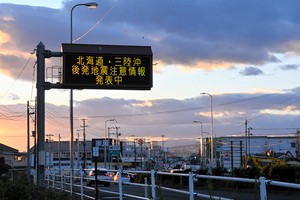By TAKAHIRO TAKENOUCHI/ Staff Writer
November 4, 2021 at 08:00 JST
 A filter in the surgical face mask embedded with an antibody to react with the novel coronavirus displays a fluorescent color near the part around the wearer’s nose (circled by dotted line) to suggest the existence of viruses, after it was tested by Yasuhiro Tsukamoto, president of Kyoto Prefectural University, following a positive COVID-19 reading. (Provided by Yasuhiro Tsukamoto)
A filter in the surgical face mask embedded with an antibody to react with the novel coronavirus displays a fluorescent color near the part around the wearer’s nose (circled by dotted line) to suggest the existence of viruses, after it was tested by Yasuhiro Tsukamoto, president of Kyoto Prefectural University, following a positive COVID-19 reading. (Provided by Yasuhiro Tsukamoto)
With his background in science, Yasuhiro Tsukamoto had a hunch he could develop a face mask that glows if the COVID-19 virus is present.
After he became infected with the novel coronavirus, Tsukamoto was convinced he was on the right track. The covering he came up with glowed when exposed to ultraviolet light, and this past summer, feeling fearful when it did, quickly isolated himself in case the virus had attached itself to the mask and infected those around him.
Tsukamoto is president of Kyoto Prefectural University and doubles as a veterinarian and animal health researcher. Soon after the glowing episode, he took a polymerase chain reaction (PCR) test and got a positive result for the Delta variant of COVID-19.
The experience prompted Tsukamoto, 52, to focus his energies on developing a face mask for general use that could alert others if the virus was present.
He treated the surface of the face mask with an ostrich-derived protein to emit light to signal the virus is present. His idea was that anyone wearing one will realize they may be infected with the novel coronavirus when the mask glowed and seek an early diagnosis for COVID-19.
“I will work to make this product available all over the world,” Tsukamoto told a news conference held in early October on the school’s campus in Kyoto Prefecture.
A leaflet distributed at the venue showed a woman wearing a mask that looks precisely the same as ordinary ones of nonwoven fabric. There was nothing about that face mask to indicate it is different from others on the market.
The secret lies in the facial protection’s internal structure: It is embedded with a filter featuring an antibody to react with the coronavirus.
Before the COVID-19 pandemic struck, Tsukamoto’s research focused on getting ostriches to produce a certain antibody in significant amounts.
In February last year, he created an antibody for the novel coronavirus. Weighing how to make effective use of the antibody, Tsukamoto chose facial protection because that is where viruses tend to congregate.
Tsukamoto then created the special filter, along with a spray agent using another fluorescent antibody that reacts with ultraviolet radiation, as well as other types of light if the virus is present.
The mechanism ensures that viruses in a mask wearer’s saliva and nasal cavity are first caught by the antibody in the filter. When the luminous antibody is sprayed on the covering, it also attaches itself to the attached viruses.
Applying black light or light given out by cellphones and other sorts of energy, the fluorescent antibody will glow. The luminous antibody reacts only to a certain range of wavelength of light.
Tsukamoto’s next step was to ascertain if his mask worked. It was at this point that he became infected with the virus.
Tsukamoto was fortunate to only come down with mild symptoms, a fever and lethargy. He continued to wear the face mask he had developed, which kept displaying COVID-19 symptoms when exposed to light. However, one he donned seven days following his recovery did not.
He noted that masks worn by more than 10 infected individuals being treated by a medical center who agreed to take part in his survey had the desired effect.
According to Tsukamoto, coverings worn by eight healthy people for eight hours did not give off light.
Feeling confident of his findings, Tsukamoto is now looking to market his face mask as an officially approved infection test kit for use at medical facilities for patients’ screening.
“If viruses on disposable masks are made visible to the eye, the spread of infection can be stopped at an early stage, giving people a sense of security,” Tsukamoto said. “I was able to verify that my mask works because I myself was infected, and the outcome was, although somewhat ironic, satisfactory for me as a researcher.”




















A peek through the music industry’s curtain at the producers who harnessed social media to help their idols go global.
A series based on diplomatic documents declassified by Japan’s Foreign Ministry
Here is a collection of first-hand accounts by “hibakusha” atomic bomb survivors.
Cooking experts, chefs and others involved in the field of food introduce their special recipes intertwined with their paths in life.
A series about Japanese-Americans and their memories of World War II